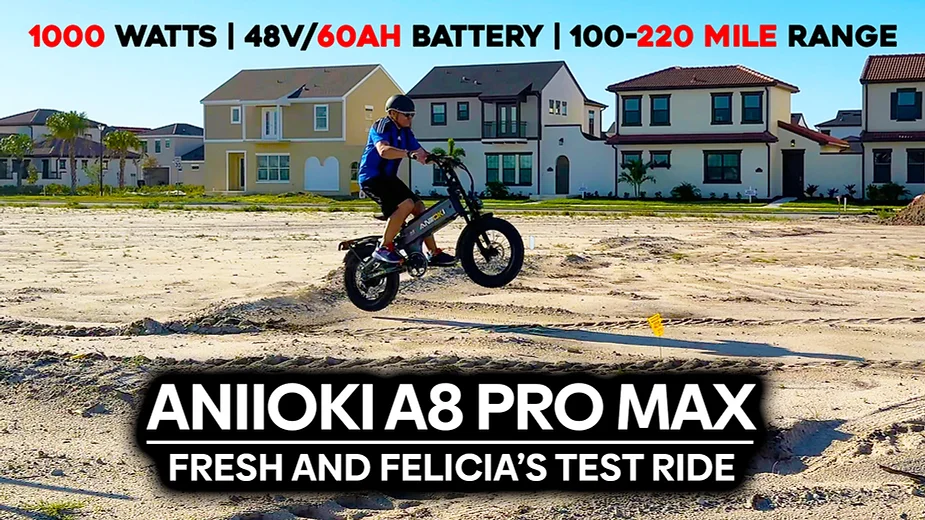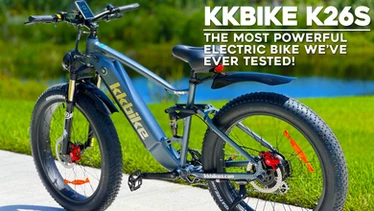This is everything you need to know before buying an electric bicycle. Electric bicycles, or “e-bikes” are everywhere! Why? Battery and electric motor technology has advanced to the point where you can travel up to 30 miles per hour for anywhere from 25-120 miles depending on how much you weigh, how many hills you ride up, and the size of your battery. This allows older people who may have breathing challenges or other medical conditions, like me, to enjoy biking again. In some places, folks have sold their cars and switched to electric bikes. If you’re not a reader, watch our video presentation on YouTube linked below.
What Is an Electric Bicycle?
First and foremost, an e-bike is a bicycle. You can pedal – if you want. And you should pedal because that gives you exercise. Keeps your muscles moving and your blood pumping. Plus, you’re in the sun, not hidden in a car. Sunlight on your skin produces natural Vitamin D, a necessary vitamin most couch jockeys or vampires don’t have enough of. And you’re helping slow the spread of carbon dioxide into the atmosphere. Yes, there’s CO2 produced when making electricity. But charging and riding an e-bike produces nowhere near the amount of CO2 a single car will produce.
Electric Bikes: Class 1, Class 2, Class 3
Most e-bikes fall into one of 3 categories that are known as “classes.” Several states have agreed on a common system of three classes: Class 1, Class 2, and Class 3. But, states will be states, and these classes differ slightly across states and manufacturers’ websites. Check your state and local laws if you’re concerned. You don’t want to get pulled over for doing 25 in a school zone on your e-bike. That might be embarrassing. Here are the latest definitions I could find.
- Class 1 e-bikes are limited to a top speed of 20 miles per hour, and the electric motor works only when the rider is pedaling.
- Class 2 e-bikes are also limited to a top speed of 20-22 miles per hour, but they have throttles that work when you’re not pedaling, as well as an optional pedal assist, like Class 1.
- Class 3 electric bicycles can travel up to 28 MPH and must have a speedometer. They may or may not have a throttle, and may or may not propel using throttle only as well as pedal-assist. Yeah, this is where it gets murky.
A throttle is what you’ll find on a motorcycle or gas scooter – you twist the handle to apply power. The more you twist, the more power you get. The most popular seems to be the half-twist, meaning it only requires minimal hand movement for full throttle. Full throttle is also available but requires more turning for more power. And a “thumb throttle” is typically a half twist with a fancy attachment for your thumb to control it. Personally, I prefer the half twist throttle.
Are Electric Bicycles Legal?
In most places, like in my home state of Florida, you can legally ride a Class 1 or Class 2 anywhere a non e-bike can ride. And that includes bike trails and most sidewalks. But check your local ordinances. Ignorance is not a valid defense in traffic court. Some states won’t allow Class 3 e-bikes to have throttles because they’re practically motorcycles. In some other states, throttles are allowed as long as they only get up to 20 miles per hour. This limit can be set by the manufacturer, and easily overridden by a savvy Googler. Some states will let you take Class 3 e-bikes on bike paths or on multi-use trails shared with pedestrians, and other states or municipalities mandate you keep them on the street.
Most of the popular e-bikes you’ll see are either Class 2 or 3. I owned a Class 1, and now that I’ve been spoiled by a throttle, to be honest, it’s hard to go back to Class 1.
How To Decide What Electric Bicycle Features You Need
Before buying an e-bike, you’ve got some decisions to make. Where are you going to ride? If you’re 70 years old and live in Florida, you probably don’t need a e-mountain bike. The more capabilities, the more you’re going to pay. So identify where you want to ride your electric bike, and what you’ll primarily use it for. Will you ride to work and back? To the local floozy’s apartment? To the quaint little park to feed the alligators? Around the neighborhood? Up crazy steep hills? On soft dirt trails? Figuring out where you intend to use this electric bicycle will help you determine what class of e-bike and the power you’ll need to make you happy. Then, you’re going to ride off into the sunset. Actually, that’s important too. You’ll need lights if you’re going to ride at night.
So how far is this place you’re typically going to ride your electric bicycle to? Don’t forget – it’s a round trip, so multiply the distance by 2. I always forget to do that. And add a reasonable buffer in there in case you change your mind and want to venture a little further when you’re comfortable on your e-bike.
This will give you the estimated range you should look for in an e-bike.
Electric Bicycle Battery Mileage or Range
The range is calculated by multiplying the Volts of the battery, typically 36 or 48, by the Amp Hours of the battery, which can vary widely. This will give you WATT-HOURS. With a little math, you can guesstimate that riding full throttle, with no pedaling, at the maximum e-bike power, will give you an hour of riding, per watt-hour. It’s a little confusing, and there are other variables that can affect range, like temperature, tire pressure, your weight, wind, how much you pedal, inclines of any hills, et cetera. You can see how range can become a tricky math equation.
Most manufacturers will guess on the total estimated range. Many e-bikes will roll somewhere between 25-50 miles between battery charges. Manufacturers tend to over-estimate, so keep that in mind. It sounds like a lot, but once you twist that Class 3 throttle and hack your controller to 28 miles per hour, you’ll have travelled 28 miles in an hour. And if your bike runs out of battery, you’ll be pedaling home for six miles at about 10 miles per hour, which will now feel like you’re crawling. Obviously, that’s oversimplified, but I think you get my gist. You’ve got some homework to do.
What Is The Safest Battery?
You have probably seen the news reports of the bike shop that caught fire in New York City. It was later found this shop was using rebuilt or off-brand batteries that were not wired correctly. Shorts or cell damage from punctures are what typically cause battery fires. The good news is most Lithium Ion batteries are completely safe and will never cause a problem.
Look for an electric bike with a battery that uses cells made by a well-known company like LG or Samsung. This way you’ll know the cells are made correctly and are less likely to catch on fire. Lithium ion technology is the same technology used in your iPhone, your computer, and thousands of other rechargeable products. When manufactured correctly, they’re completely safe, powerful and have no memory effect. Most e-bikes use LiPo batteries.
If you plan to ride beyond the bike’s recommended range, you can purchase a second battery that you can swap out when necessary, so make sure the battery is removable. And, if you plan to keep your bike for more than two years, it’s good to have the capability to replace the battery when necessary. Most batteries are rated at well over 500 full charges, but this can vary based on usage, storage, temperature, and a number of other factors. The bigger the battery, the higher the cost. Don’t buy more than you really need.
We recommend storing your batteries in a garage or somewhere close to an outside door just in case. Again, you shouldn’t have any issues with reputable battery manufacturers, but with shady dealers or second-hand electric bicycle purchases, you never know what they’ve done inside.
What Size Motor Do I Need?
The other factor in range is the size of the motor your electric bicycle will use to move you around. And size does matter. Or it could be argued it depends how you use it, but again, I digress. And don’t ever make the mistake of calling a motor an “engine.” Some mechanic really let me have it when I did that. It’s kind of like calling a cruise ship a boat. Some people are super picky.
You’ll see electric bicycles with motors from a paltry 250 Watts like the Sondors sold at my local Costco, which is really too slow for anyone. You may see a monster 1500 Watt e-bike sold on Amazon. The bigger the motor, the more torque you’ll have, the more hills you can climb, and faster your bike can travel.
But there are tradeoffs to bigger motors. Bigger motors require bigger batteries. They also add more weight to the e-bike. And, bigger motors are more expensive. If you’re cruising the neighborhood and local parks, and your area is pretty flat, like mine, a 500 Watt motor Class 2 e-bike will comfortably take you up to about 22 miles per hour for a really good range. If you’re serious about riding a bike on mountain trails, or if you have very steep inclines in your area, you will definitely need the additional torque a 750 or 1000 Watt motor will provide. And remember, what goes up must come down. Make sure you’ve got good disc brakes. These come standard on most newer e-bikes.
Torque vs Cadence Sensor Motors
When you’re pedaling an e-bike, and you turn on the pedal assist feature, there are two ways your e-bike’s computer guesses how much power to provide to help you along. Cadence sensing uses magnets to track how fast you’re pedaling, and provides power based on that speed. Torque sensing, found on some $3000+ bikes, is more expensive because it tries to track how hard you are pedaling. The harder you pedal, the more motor help it gives you. Most newer sub $2000 bikes use cadence sensing, and manually offset the amount of help it gives you by asking you what pedal assist level you’d like to use. Many bikes have PAS settings from 0-3 or 0-5. A lower PAS setting means it’ll help you get to a certain speed based on how fast you’re pedaling, and then stop providing motor power until you pedal like crazy again.
Many manufacturers don’t disclose if you have cadence or torque sensing. Assume it’s cadence if it’s not clear. There’s nothing wrong with cadence. All my bikes have cadence sensors. But, you’ll run into some e-bike snobs at e-bike meetups who will thumb their torquey noses at you for having a cadence sensor. You can laugh to yourself knowing these snobs probably have tiny disc — brakes.
Electric bicycle suspension
Many e-bikes come standard with front fork suspension, which helps avoid scrambling your brains when you run over something lumpy. But a short moment later, when your rear wheel hits the lumpy thing, your brains will end up getting scrambled anyway. I personally don’t have many brains left to scramble, so there’s that. I prefer front and rear suspension, and especially if you’re over 40. Some e-bikes will offer rear suspension in the form of actual shock absorbers on the rear wheel, others integrate it into the seat post. I have bikes with one or the other or both, and I definitely prefer dual suspension.
Your e-bike will probably come with a standard hard seat. You’ll find most people upgrade their seats to one of those cushy Cloud 9 seats. They’re very nice, and not too pricey either. Use our affiliate link and browse Amazon here: https://amzn.to/3qsCwde
For balance and aerodynamic reasons, mountain e-bikes and racing e-bikes tend to have handlebars that are at about the same height as the seat, which can be super uncomfortable on longer rides. There are some models made specifically for cruising where the handlebars are adjustable or at a better height. There are extensions and third-party add-ons that can remedy that situation as well. Use our affiliate link to help pay for our website (thanks!): https://amzn.to/3KEMUFH
Are Electric Bicycles Too Big For Me?
Some of the 26″ electric mountain bike models are quite big, so people under 6 feet tall may have a problem riding some of these comfortably. Fortunately, there are several sizes to choose from, from 20” wheels all the way up to 29” wheels. The most common wheel sizes are 20 and 26 inches. If you’re less than 5’9”, a 20” e-bike is probably your best bet. Make sure the seat height is adjustable – some of the smaller cargo or mountain bikes have fixed seat heights that might end up being too high. Take a test ride at a local dealer if that’s an option.
Step-Thru or Fixed Bar
And then there’s the step thru vs non step through option. Step-thrus lose that annoying bar you have to step over. They used to call step-thrus ‘girl bikes” because women used to have to wear dresses when riding bicycles in the old world. True story. Today, it doesn’t really matter. People who do deliveries and older folks like me who just don’t wanna kick our legs up that high anymore ride step thrus. There’s no difference functionally between a step through or a bike with a ball buster bar.
How Much Do Electric Bicycles Weigh?
Most electric bikes are heavy. Two of mine with 750 Watt motors are over 80 pounds each, and my latest dual battery model weighs in at 102 pounds. Sooner or later, you’ll probably need to lift that thing somewheres. If you want to hang your bike on a wall rack or on the back of a car or truck, standard bike racks are probably too weak to hold an e-bike safely. Check the weight limits of your rack. Most Class 2 and Class 3 e-bikes weigh somewhere between 50-70 pounds. There are some Class 1 models with smaller motors and batteries that weigh in at 35 pounds that will fit on most bike racks, and are easier to carry up stairs if you ever need to do that. I have a 35 pound Class 1 e-bike I keep in a closet just because I can.
If you want to tote your e-bike down the highway or across the causeway, you’ll need to lift that big boy into the back of your car or truck. Again, they’re heavy. Lift with your legs, and all that fun stuff. Use a ramp if you have one.
Some e-bikes are foldable, with a heavy duty steel hinge. That is super helpful for traveling with or storing your e-bike in smaller spaces. Most foldables are smaller electric bicycles with 20″ wheels, but there are full-size 26” ebikes that are foldable too.
Will I need insurance for my electric bicycle?
E-bikes are expensive, and there’s a high theft rate. So keep in mind you’ll need to store your e-bikes somewhere dry and secure. Chaining it up to your front gate won’t keep a dude with bolt cutters or a cordless drill from quickly popping your thousand dollar investment into his old pickup. It happens. Keep it in a garage, or indoors if you have an apartment. I have two chains and a loud motion sensor alarm on one of my e-bikes just for laughs.
Here’s the thing. E-bikes are still kind of a new thing. But all it takes is one idiot 20-something with a 1500 watt e-bike going way too fast on bike path who mows down a first grader and everything hits the fan. E-bikes are faster, so they’re harder to stop. There’s more chance of injury to you, and potentially someone else. Insurance underwriters won’t spend the time to look at something until they have to, and you really don’t want to be a guinea pig in a room filled with lawyers working against you.
An e-bike traveling 20-28 miles per hour assumes many of the same risks as motorcycles. We’re talking loose gravel. Potholes. Deer. So you’re probably going to need two types of insurance.
Won’t My Homeowner’s Policy Cover My Electric Bike?
I pulled out my homeowners policy – under contents coverage… property not covered includes “any engine or motor propelled vehicle or machine, including the parts, designed for movement on land”. Coverage only extends if the vehicle or machine is used solely to service the property or assist the handicapped. So any motorized vehicle that’s not a wheelchair or lawnmower is not covered, and may be considered a moped or motorcycle. So if it’s stolen or damaged, sorry, it’s not covered.
In some states and in some policies, a Class 1 E-Bike with pedal assist only is still considered “just a bike” and is covered, even though the motor has a max of 22 mph like the Class 2. Remember, the difference is there’s no throttle.
Then there’s that liability monster. If a kid or dog runs out in front of my throttle bike, I probably have zero liability insurance coverage under my homeowners or auto policies and could be liable for damages of tens of thousands or even more. Since e-bikes are still so new, the current catch-all solution is to purchase motorcycle coverage for liability. If you want to be covered for theft, damage, medical, uninsured motorist or underinsured motorist, that would probably be additional. Rules do vary widely from state-to-state and even carrier-to-carrier, so check with your state and agent, and protect yourself – don’t ever accept a vague answer. Make him earn his commission.
Electric Bicycle Repairs and Warranty
Check the warranty period before you buy. Things happen no matter what company you choose, and yes, even the “American e-bike companies” that are really front-ends to Chinese manufacturing. Most reputable companies offer a two-year warranty on parts only. Labor is typically on you simply because of logistics. It’s a little hard to get a bike to a service center in China and back. E-bikes typically make a one-way trip. That’s the advantage of spending a little more and working with a local brick and mortar store.
If you’re handy and can replace parts yourself, you won’t have to worry about local service. Some of these parts including the motor can be very intricate and may need to be completely disassembled. Oh yeah, I’ve heard some stories. So make sure there’s a qualified or authorized local e-bike service center or person in your area. For a myriad of reasons, many old-school bicycle shops won’t work on e-bikes they don’t sell, so don’t assume they will.
What About Warranties for Online Bikes?
If you end up ordering online, that’s cool too. There are some really good deals online. But do your homework, and find one of these resellers who has been around a few years, has a good reputation, and a proven customer service track record. A few companies have phone numbers that ring in China, and there’s a huge language barrier. Look for someone who has North American support just in case something goes wrong. There are a ton of horror stories on social media, yes, even from the supposed “American” e-bike companies, so join some of the groups and do your homework.
I’ve seen e-bikes on Amazon for as little as $500, and ads show up in my socials for a Jeep- or Mercedes branded bike for as high as $10,000. Your budget will be a large part of your deciding factor. But I can tell you there are some very good Class 2 and Class 3 electric bicycles in the sub – $2000 range. If it’s your first e-bike, it’s probably a good idea to start with a less expensive brand or model to see if it’s for you. If not, return shipping is very expensive, but it’ll be easier to locally sell a lower priced e-bike. And again, check your local ads for slightly used bikes.
OK! That’s my thesis. What did you think? I’m sure you have more questions now than you did when we started, and that’s good. You’re thinking. Information is power!
Where Should I Buy an Electric Bicycle?
You can’t beat Amazon’s financing and return policies, plus the convenience of having the bike delivered to your front door. As you’ve probably seen in our popular YouTube videos, assembly is very easy, since most of these bikes (especially the foldables) are 90-95% assembled out of the box. Take a look at our Amazon Electric Bicycle idea list here, and read the descriptions and the reviews. We have bought two from Amazon, and it’s a great way to buy an electric bike. AMAZON IDEA LIST: ELECTRIC BICYCLES
We’re also affiliated with several electric bicycles we’ve tested on our YouTube channel. Watch the reviews to see the features of each model. If you choose to buy one, please use our sponsored links in the description of our YouTube videos, or below, and we may earn a small commission from your purchase. Don’t worry – your price won’t increase. As a matter of fact, our links may save you a few dollars!
- NAKTO: Use discount code FRESH60 for $60 OFF your order https://nakto.com/products/super-cruiser
- WALLKE: https://wallkeebike.com?aff=78
- ENGWE: https://shareasale.com/r.cfm?b=2286723&u=3156491&m=111433&urllink=&afftrack=
- MOKWHEEL: https://www.mokwheel.com/?aff=2
- KBO: https://kbobike.com?sca_ref=1537177.y9J9utE8rJ
- HEYBIKE: https://www.heybike.com/products/heybike-mars-electric-bike?ref=freshandfelicia&utm_medium=goaffpro&utm_source=affiliate
- JASION: https://www.jasionride.com/?ref=34uw948hg0
- MAGICYCLE: https://www.shareasale.com/u.cfm?d=875235&m=111475&u=3156491
- WTVA: https://wtvabikes.com/?ref=34uw948hg0
- RIDE1UP: https://ride1up.com/product/core-5/?wpam_id=760
Thank you!




